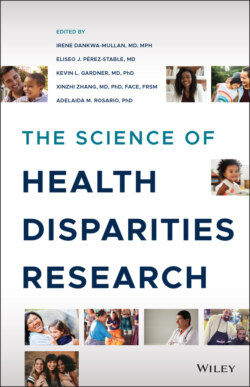Читать книгу The Science of Health Disparities Research - Группа авторов - Страница 35
2.4.1 Studies of Stress and Allostatic Load Across the Life Course
ОглавлениеThe concept of allostatic load and the biomarkers used to study it have been widely accepted in studies of how behavioral, social, and biological exposures combine to influence the wear and tear on the human body and predispose it to disease. Numerous biomarkers are now in frequent use in many studies and are gradually providing a clearer picture of the role of stress and allostatic load in health disparities [3, 29]. For example, a review by Rodriquez et al. describes markers of allostatic load (e.g., systolic and diastolic blood pressure; hemoglobin A1c; C‐reactive protein; dehydroepiandrosterone; cortisol; telomeres) representing multiple biological systems (e.g., cardiovascular, metabolic, inflammatory, neuroendocrine) that are derived from research among minority and disparity populations (see Table 2.1) [30]. Research is also showing that measures of allostasis differ by racial/ethnic group and, therefore, need to have a range. For example, cardiometabolic risk factors for Whites with a body mass index (BMI) of 25 appeared at a much lower BMI than in patients from other groups: 22.9 for African Americans, 21.5 for Hispanics, 20.9 for Chinese, and 19.6 for South Asians. After controlling for lifestyle factors such as smoking, alcohol intake, exercise, and diet, only 21% of Whites had cardiometabolic risk factors but normal BMIs, whereas 39% of Hispanic Americans and 44% of South Asians had a normal weight but a higher risk for chronic diseases that are usually associated with being overweight [31].
Table 2.1 Representative list of biomarkers for allostatic load [3, 22].
| Biomarkers of allostatic load | ||
|---|---|---|
| Biomarker | Function | Typical measures |
| Cardiovascular | ||
| Systolic blood pressure | Cardiovascular activity | Mean of 3, resting, (mm Hg) |
| Diastolic blood pressure | Cardiovascular activity | Mean of 3, resting, (mm Hg) |
| Heart rate | Cardiovascular activity | Mean of 3, resting, (bpm) |
| Peak expiratory flow | Lung function | Highest of 3, Peak flow, (l min−1) |
| Metabolic | ||
| HDL, mmol l−1 | Low levels, unfavorable | Serum, nonfasting, (mmol l−1) |
| LDL | Low levels, favorable | Serum, nonfasting, (mmol l−1) |
| Triglyceride | High levels, unfavorable | Serum, nonfasting, (mmol l−1) |
| Total cholesterol/HDL | Low levels, favorable | Ratio <5.9 |
| BMI | Measure of adiposity | BMI >30 |
| WHR (waist: hip) | Abdominal adiposity | WHR >9.94 |
| HbA1c | Measure of insulin resistance | mmol mol−1 |
| Inflammation | ||
| IGF‐1 | Inflammation | Serum nonfasting, (nmol l−1) |
| Fibrinogen | Blood clotting, thrombosis risk | Serum, nonfasting, (g l−1) |
| IgE | Type I hypersensitivity | KU l−1 |
| CRP | Acute inflammation | Citrated plasma, (mg l−1) |
| Neuroendocrine | ||
| DHEA‐S | HPA antagonist | Urinary, (ng ml−1) |
| Cortisol t1 | HPA function | Salivary, 45 after awakening, (nmol l−1) |
| Cortisol t2 | HPA function | Salivary, 3 after awakening, (nmol l−1) |
| Epigenetic | ||
| DNA methylation | Embedded cellular aging | Circulating white cells |
| Telomere shortening | Cellular aging | Circulating leukocytes |
HDL, high density lipoprotein; LDL, low density lipoprotein; WHR, waist to hip ratio; CRP, C‐reactive protein; DHEA‐S, dihydroepiandosterone sulfate; HPA, hypothalamus pituitary adrenal axis.
Several cohort studies have documented clear associations between adverse childhood experiences and allostatic load for both men and women, with major influences on health behaviors, BMI, and socioeconomic factors in adult life [29]. Studies measuring allostatic load across ethnic and racial populations demonstrate how a multitude of social factors, including discrimination, can contribute to overall allostatic load, significantly alter health aging, and act as an early indicator of subsequent disease burden [32].
In the following sections, we provide examples of how such studies are increasing our understanding of causal mechanisms and how they impact health disparities and provide new and important insights for future interventions.
